To remove moisture from binoculars, follow these steps:
- Remove the Binoculars from the Case: Remove them from their case to allow air circulation.
- Open the Lens Caps and Covers: Remove all lens caps and covers to expose the lenses.
- Place Binoculars in a Dry, Warm Environment: Put the binoculars in a warm and dry place, such as a room with low humidity, for at least 24 hours. You can place them near a fan or use a gentle heat source, like a desk lamp, to expedite the process.
- Use Desiccant Packets or Rice: Place the binoculars in a sealed bag with desiccant packets or uncooked rice. These absorb moisture effectively. Leave them for 24-48 hours.
- Check for Moisture: After the waiting period, check if any moisture remains. If there’s still condensation, repeat the process.
- Avoid Direct Sunlight: Avoid exposing the binoculars to direct sunlight while drying, as it can damage the optics.
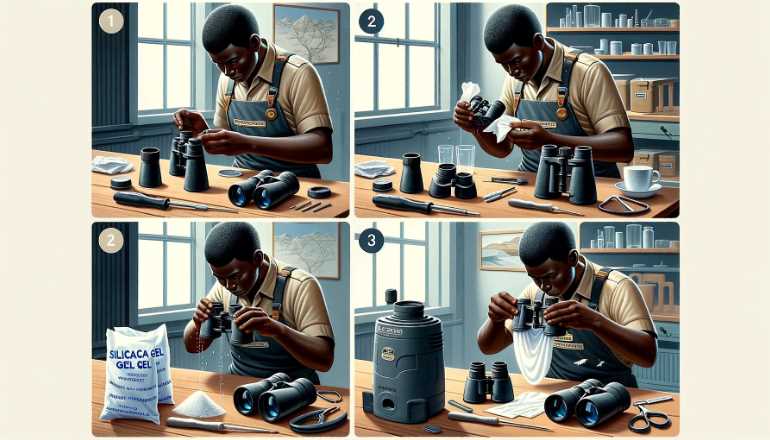
Moisture inside binoculars can degrade optics and affect performance. Removing the moisture involves allowing the binoculars to air-dry in a warm, low-humidity environment. Desiccant packets or rice can expedite the process by absorbing moisture. The objective is to eliminate condensation and ensure the binoculars are completely dry before use.
| Step | Action | Details |
|---|---|---|
| 1 | Remove Binoculars from Case | Enhances air circulation around the binoculars. |
| 2 | Open Lens Caps and Covers | Exposes the lenses for effective drying. |
| 3 | Place in a Dry, Warm Environment | Choose a room with low humidity or use a gentle heat source. Leave for at least 24 hours. |
| 4 | Use Desiccant Packets or Rice | Seal binoculars in a bag with desiccant or rice for 24-48 hours. |
| 5 | Check for Moisture | Ensure no condensation remains. Repeat the process if necessary. |
| 6 | Avoid Direct Sunlight | Protect binoculars from direct sunlight during the drying process. |
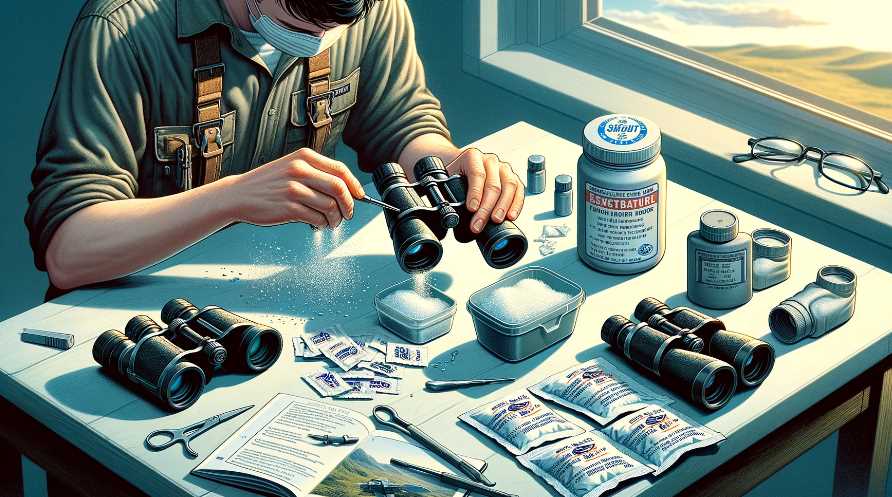
Why do binoculars get moisture?
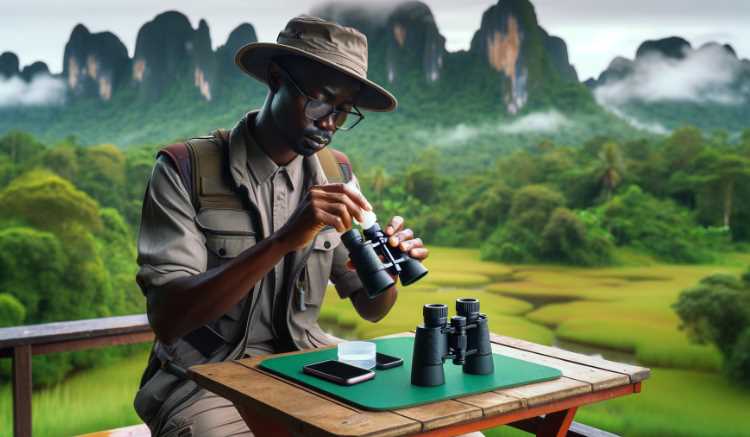
Binoculars can get moistened for a few different reasons. One common reason is that they are often used in humid or wet environments, such as during rain or while hunting. This increased moisture can cause the rubber parts of the binoculars to deteriorate and eventually leak.
1. Sunlight: When you use your binoculars, the sunlight passing through the lens causes them to become moist.
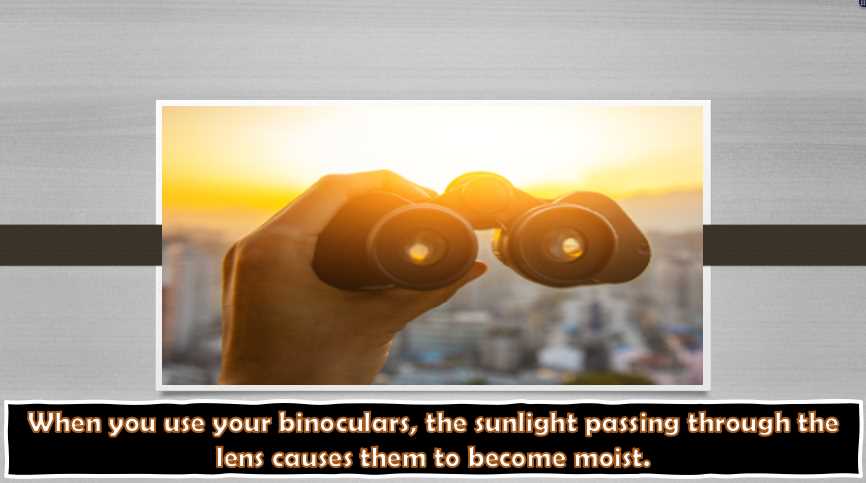
2. Airflow: The ventilation system on a pair of binoculars pulls air in and out of the lenses, which causes condensation.
3. Dew Point Formation: Bins have tiny metal parts that get heated up when used in cold weather and create vapor called dew points; these dew points attract water droplets from the surrounding air (a process known as hygrometry).
4. Barrel Shaping & Polishing: Metal barrels are polished to reduce reflections inside and outside objective lenses while keeping light transmission high. Hence, images appear bright, clear, and true-to-life no matter what lighting conditions exist when viewing an object or scene through your binoculars.
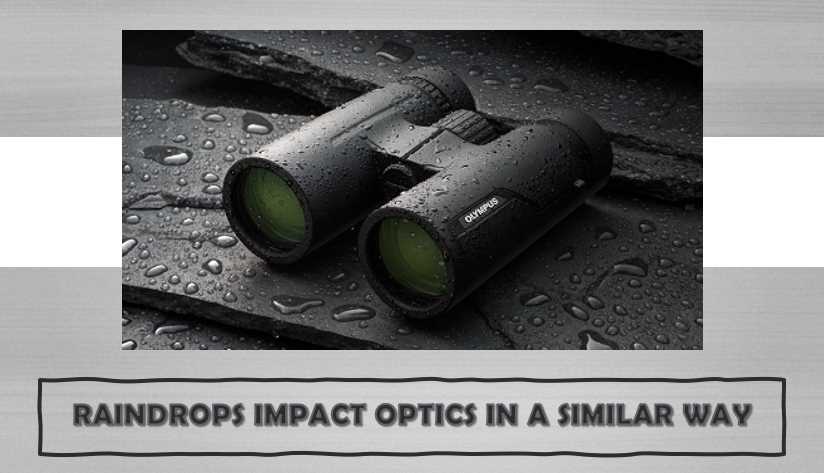
5. Raindrops: Raindrops impact optics in a similar way; when they strike one side prism more than another side, much higher pressure is created that forces oil and moisture out of cracks in coatings on lenses/prisms interface either by capillary action or vented gas whistling through tiny gaps between particles, etc.
Why is it necessary to remove moisture from binoculars?
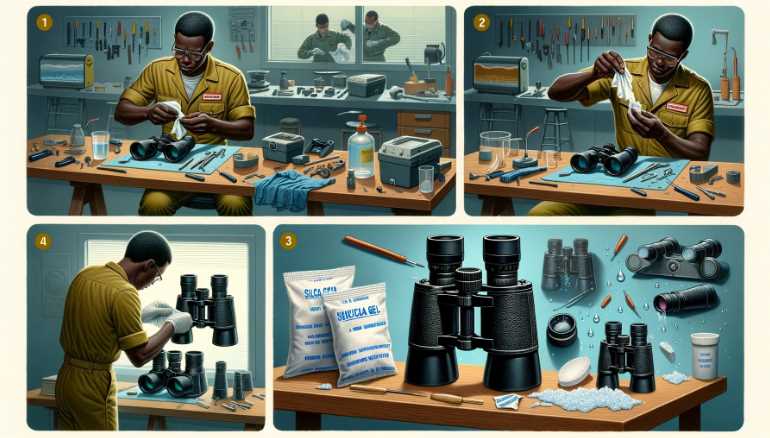
Removing as much moisture as possible when storing binoculars is essential, so they don’t become damaged. Moisture can cause wood to swell and split, lenses to fog up and corrode, and metal parts to rust.
Additionally, it can attract pests such as moths or insects that may damage your equipment. There are a few ways to remove moisture from binoculars.
To reduce the amount of moisture in your binoculars, store them in a dry location away from drafts and sunlight. Store them in an airtight container if possible so that the humidity levels remain low. Keep distilled water nearby for quick drenching when needed.
Another reason you might want to remove moisture from binoculars is if the lenses are visibly foggy. This can be due to condensation forming on the lenses when cold and humid outside.
To clear the lens, gently wipe it with a cloth or paper towel, then dry it thoroughly. Do not use any filter, as this will only worsen things.
If you’re having trouble removing moisture from binoculars, consult the manufacturer’s instructions. Binocular lenses can also be treated with a spray that helps to suppress fogging.
Binoculars can easily accumulate moisture inside due to the condensation produced by using them. This moisture can cause damage to the optics and make it difficult for you to see clearly. Removing as much water as possible before storing your binoculars is necessary to prevent this from happening. You can do this by letting them air-dry or using a dehumidifier.
NOTE: If you have ever dropped your binoculars and they’ve sustained damage, it’s essential to take them in for service. Drops can cause the lenses to crack or otherwise suffer permanent damage.
11 ways to Follow: Removing moisture from your binoculars
Removing moisture from your binoculars can be tedious and time-consuming, but there are a few simple steps to make the process a little more manageable. We have outlined eleven ways to remove moisture from your binoculars easily and efficiently. Hopefully, this guide will help you finish the job quickly and without any unpleasant surprises!
1. Put them in the Sun Naturally or in a Warm Location
There are a few different ways you can dry out your binoculars naturally:
– Put them in the Sun: Place your binoculars in direct sunlight for a few hours, and they will be dry to the touch. Be sure to take them out of the sun periodically, so they don’t get too hot.
– Put them in a warm location: If you have a warm location where you can put your binoculars, this is the best way to dry them out. Just make sure that they’re not too hot or humid and that they’re protected from rain or snow.
2. An Airtight Container with A Desiccant Such as Silica Gel or Baking Powder
To remove moisture from your binoculars, you can use an airtight container with a desiccant such as silica gel or baking powder.
First, use these methods to ensure that the binoculars are completely dry.
Then, place the binoculars in the airtight container and add the desired amount of desiccant.
Finally, seal the container tightly and let it sit for a few days to absorb all the moisture. Once it’s done, you can take them out, and they will be ready to use again.
3. Use A Dew Point Repeater
A dew point repeater is a device that helps you to control the internal humidity levels of your binoculars. It does this by emitting a small amount of cool air every time it senses that the ambient temperature has dropped below a predetermined level. This cool air then condenses on the surface of the optics, removing any moisture that may have formed there.
You can buy dew point repeaters online or in specialized stores, which are usually quite affordable. They should only take 10 minutes to set up and will save you much hassle in the long run!
4. Preventing water from getting into your binoculars
There are a few ways you can prevent moisture from getting into your binoculars.
The first step is ensuring that the binoculars are sealed tight when not used. This will help to keep moisture out and preserve their overall condition. You can also store them in a dry place or pack them in an airtight container if they’re not used often.
If you get moisture inside the binoculars, the best way to deal with it is to put them in a spray bottle filled with water and let them sit for several minutes. This will cause the moisture to evaporate, and the binoculars can be used as normal.
5. Choosing Proper Fogproof Binoculars
If you frequently use your binoculars in cold or wet climates, it’s vital to buy Fogproof binoculars to protect them from the moisture and dirt that can cause them to fog up.
Fogproof binoculars are designed to prevent the build-up of moisture and dust on the lenses. They also have a seal that stops water and air from entering the instrument, keeping it clean and free from fog.
One of the best things about Fogproof binoculars is that they’re not just for use in cold or wet climates but also in humid environments like jungle safaris or rainy hiking trips. If you use your binoculars a lot in any environment where moisture is a problem, then buying a Fogproof model is the best decision you can make!
6. Clean Binoculars Appropriately
To clean your binoculars properly, you must remove all the moisture and dust. To do this, follow these steps:
First, cover the entire surface of the binoculars with the cloth. Make sure that all of the lenses are covered.
Then, pour enough soap into your hand until it is lathery. Rub the soap around each lens gently and carefully until all dirt and moisture are removed.
Finally, rinse the lenses with water to remove any soap residue.
7. Rub your lenses with a soft cloth
Moisture is the enemy of binoculars. It can cause condensation and fog, which will eventually damage your lenses. To prevent this from happening, you should regularly rub your lenses with a soft cloth to remove the moisture. This will help clear the lenses of condensation or fog and make them ready for use.
8. Use a hairdryer on low heat.
If your binoculars are getting wetter and wetter, it’s time to take action. The best way to remove moisture from your binoculars is using a hairdryer on low heat.
To do this, plug in your hairdryer and set the temperature low. Once the hairdryer is switched on, turn it towards the binoculars and hold them close to the heating element.
Be careful not to touch the lenses with your hands or anything else – just let the hairdryer do its job! You’ll be able to see the foggy lens surfaces start to disappear, as well as see any water droplets that have formed on them dissolving away.
9. Use an electronic humidifier.
If you’re looking for a quick and easy way to remove moisture from your binoculars, you should try using an electronic humidifier.
This device plugs into your wall socket and absorbs water from the air. When it reaches a certain humidity level, it switches on and releases this moisture into the air. This will help to remove any residual moisture from your binoculars so that they are ready to be used again as soon as possible.
Just ensure you get the right type of electronic humidifier for the job. Some humidifiers work by spraying water droplets all over the lenses, which can be messy and damage them over time.
Instead, choose a model that uses ultrasonic waves or steam to distribute the water evenly across the lenses. This will help to protect them from damage and also keep them clean.
10. Spraying them with anti-fog spray
One easy way to remove moisture from your binoculars is to spray them with anti-fog spray. This will help prevent the eyepieces from fogging up, and you’ll be able to see better in low light conditions.
You can buy anti-fog sprays in most store chains or mix equal parts of ammonia and water and spray it through the eyepieces. Make sure to do this before using your binoculars so the solution has time to work its magic.
11. Soaking them in hydrogen peroxide
There are a few ways to remove moisture from your binoculars: soaking them in hydrogen peroxide, using a vacuum cleaner with a wet/dry filter, or spraying them with a hose.
The soaking method is the most effective and least damaging of the three. To soak your binoculars in hydrogen peroxide, fill a container with enough hydrogen peroxide to cover the lenses (ensure the container is secure so it doesn’t spill). Submerge the binoculars in the solution and leave them there for at least an hour or overnight if possible.
Be sure to shake the binoculars occasionally to distribute the solution evenly. After soaking, gently wipe off any excess water with a cloth and dry them thoroughly before use.
If you don’t have access to hydrogen peroxide or want to avoid damage to your equipment, you can try using a vacuum cleaner with a wet/dry filter. Place the binoculars inside the filter bag and turn on the vacuum cleaner.
The filters will capture all of the moisture inside the binoculars and release it into the air as dry dust particles. Be sure to replace your filters regularly to capture all the moisture inside your binoculars.
Finally, you can spray them with a hose if they’re still wet after attempting either of the other two methods.
What should I do if my binoculars are fogging up all the time and fungus is growing inside?
If you are experiencing problems with your binoculars, it is important to take them in for repair as soon as possible. It may be that the lenses or eyepieces have become foggy due to moisture, and fungus has started growing inside. If this is the case, getting them repaired as quickly as possible is best so you can continue using them safely.
In addition, make sure to keep your binoculars stored indoors and away from direct sunlight. This will help prevent the growth of fungus and minimize any potential damage from water droplets on the lens surfaces. And lastly, use a humidifier if needed to avoid adding too much moisture into the air where they are stored.
How do you defog the inside of binoculars?
To defog the inside of binoculars, you need to use an air blower or vacuum cleaner. Open both binoculars and aim the blower or vacuum cleaner toward the objective lenses. Be sure not to direct any wind directly into your eyes! After blowing or sucking for about 10 seconds, close both bins and wait about 30 minutes for them to dry before using them again.
By using a lens cleaner, you can defog both eyeglasses and binoculars. Spray the cleaning solution onto a cloth and wipe both lenses clean. Be sure to avoid contact with the eyes when cleaning your glasses or binoculars!
Take Away
As you can see, removing moisture from binoculars is not rocket science. All you need are safe steps, a few tools, and plenty of time. After reading the blog, you know where to get the best binoculars that don’t make your eyes feel uncomfortable and dry. Also, use a reliable anti-fog spray for glasses after handling regular binoculars. It will help keep your glasses safe from any dirt and debris.
The best way to get rid of any moisture in a binocular is by making sure it stays scorched for as long as possible. This means that taking out your pair at the right time is crucial. Once the humidity drops, place them back in their box so they can be stored properly for future use!
If you have left your anti-fog spray home, we recommend using ECCO PURE Anti Fog Spray for Glasses. It is a long-lasting effect and reliable travel companion, which can fix any moisture issues without leaving an aftertaste behind!

I am an enthusiastic student of optics, so I may be biased when I say that optics is one of the most critical fields. It doesn’t matter what type of optics you are talking about – optics for astronomy, medicine, engineering, or pleasure – all types are essential.
Last update on 2025-07-15 / Affiliate links / Images from Amazon Product Advertising API
Table of Contents






Pingback: Why Do Binoculars Have Red Lenses